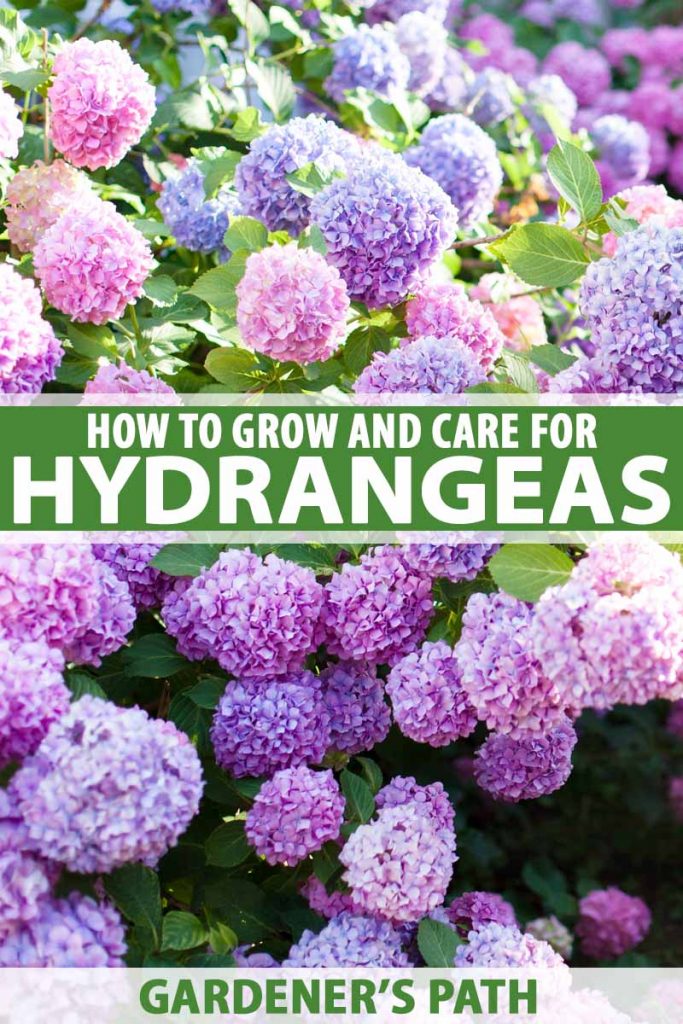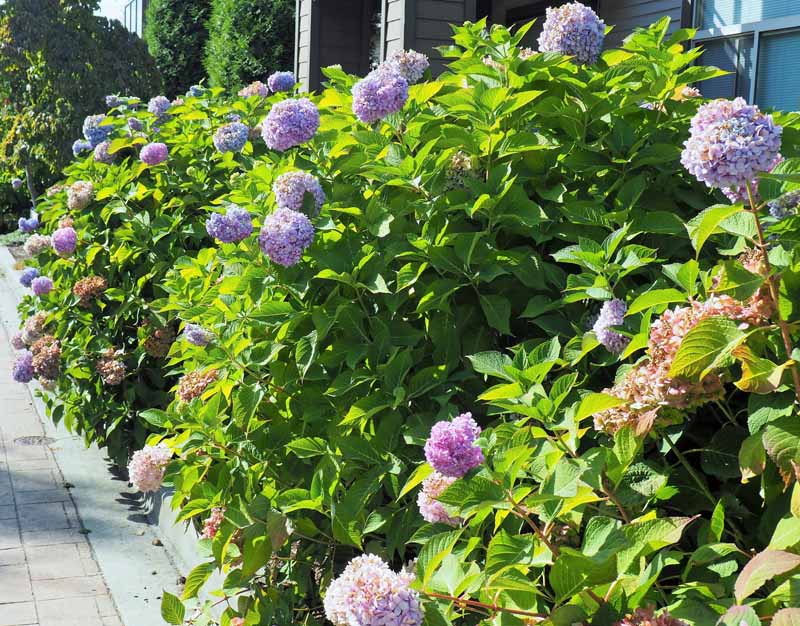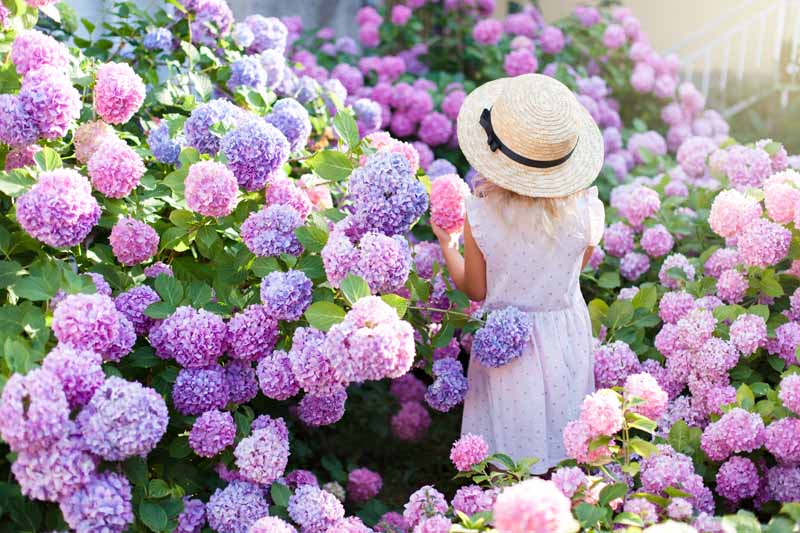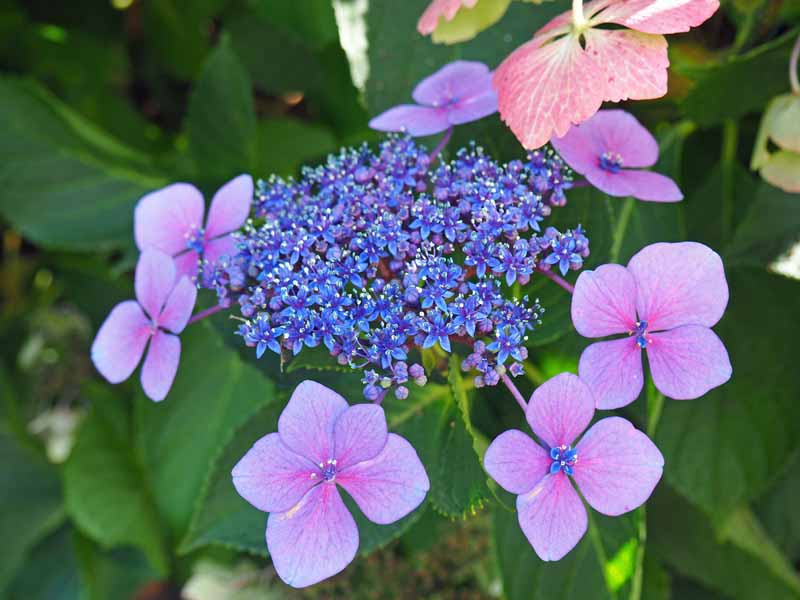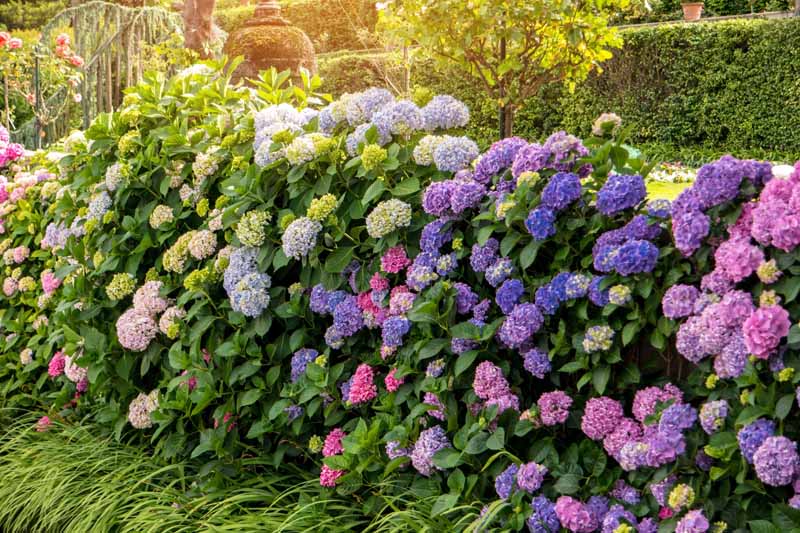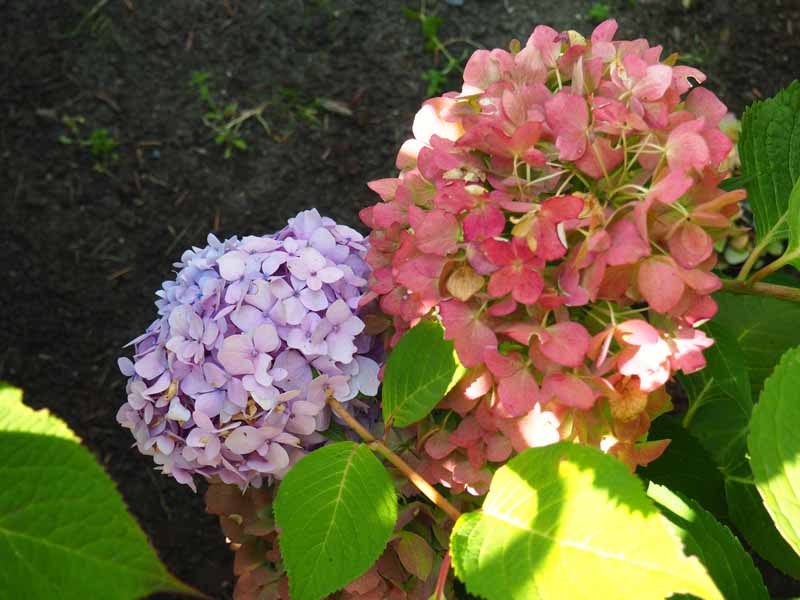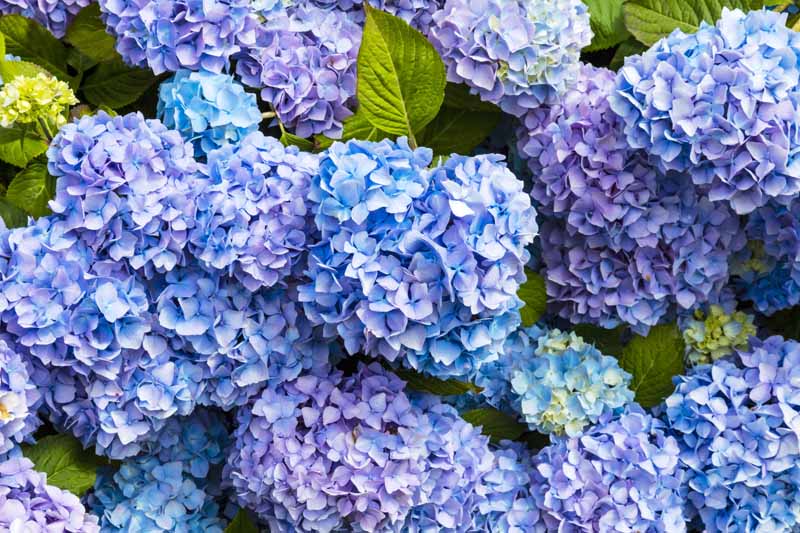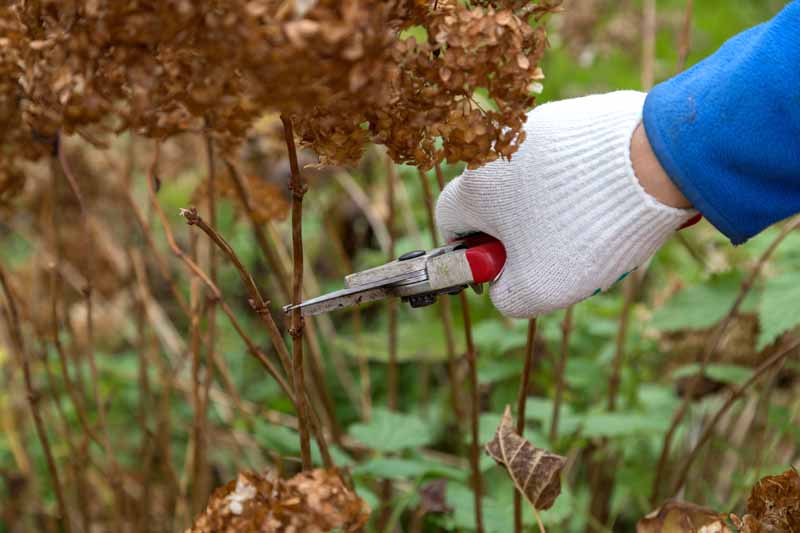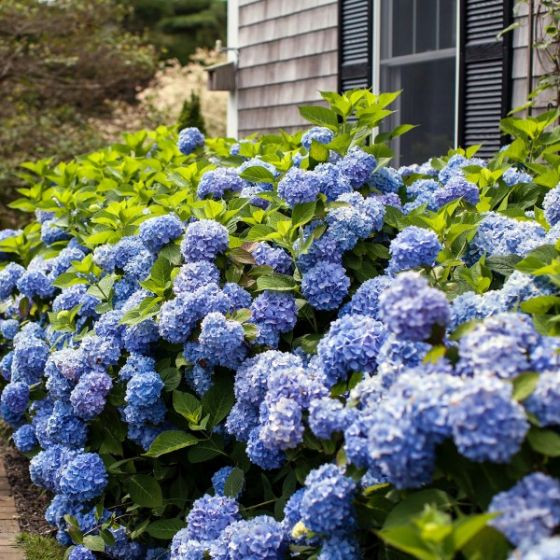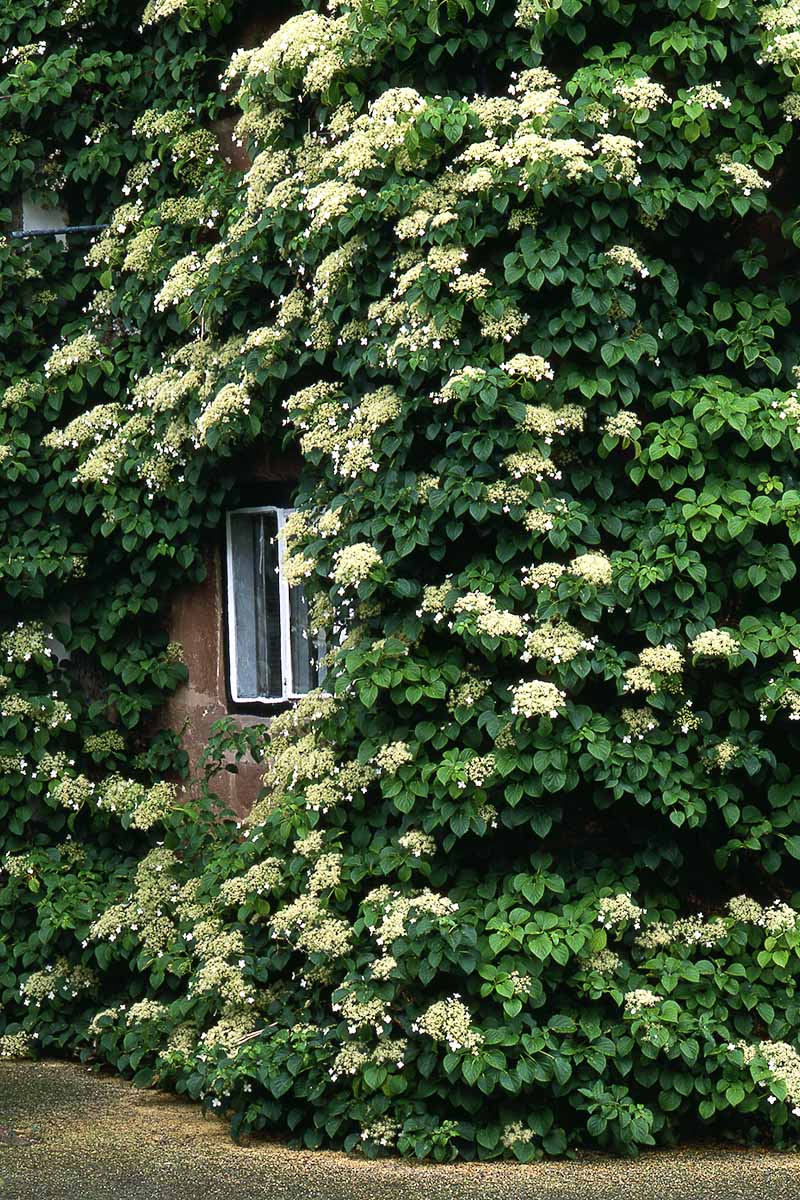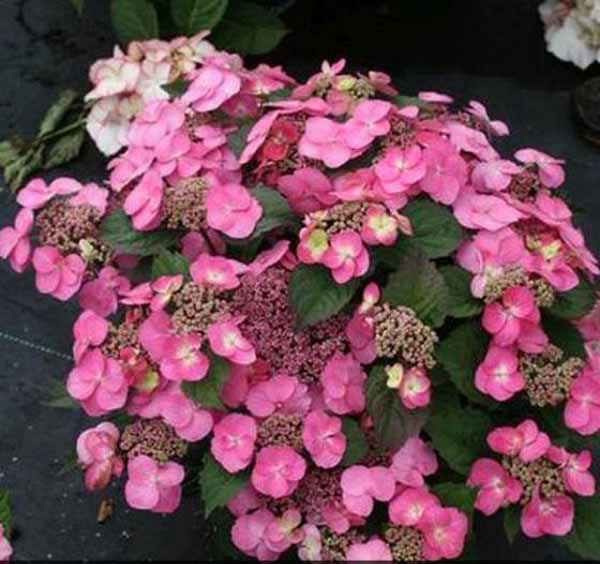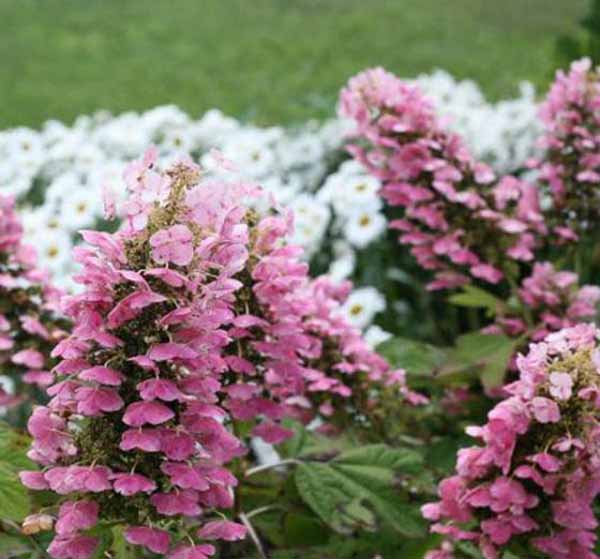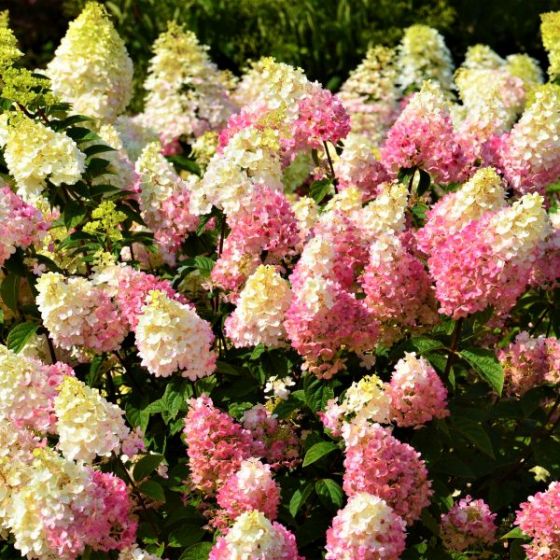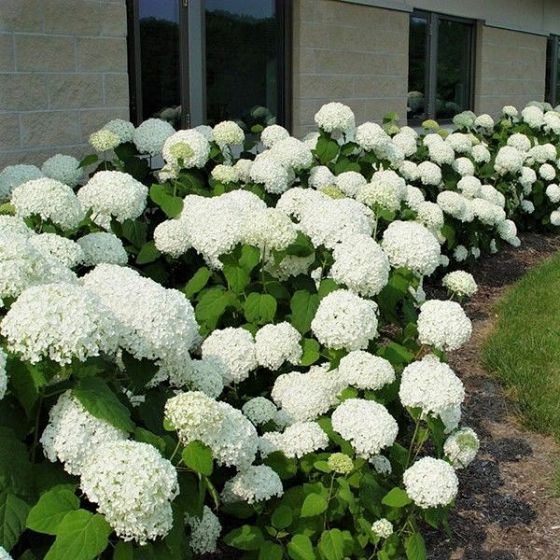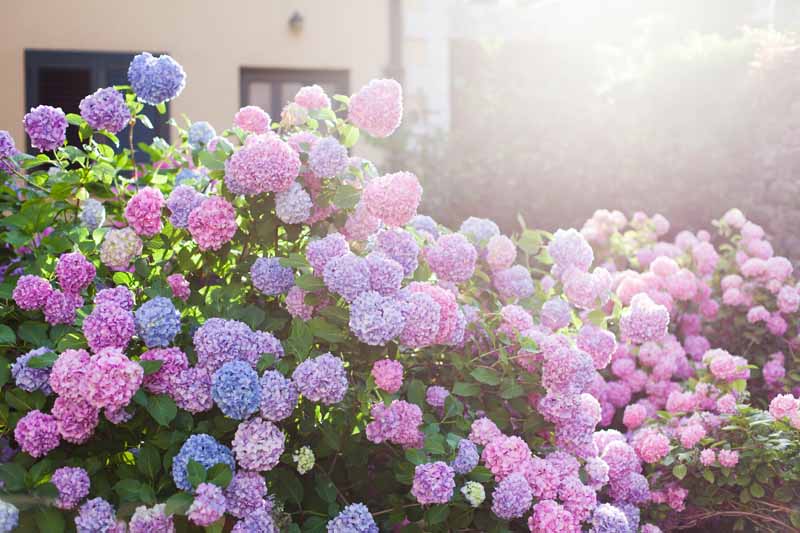With fantastic, large flowerheads in colors of blue, lime green, mauve, pink, red, and white, they showcase an old-fashioned beauty that begs to be seen and admired. Their immense blooms make them a stand-alone in woody shrubs. These lovely plants are easy to cultivate, not fussy about soil requirements, and produce copious amounts of flowers that last well into fall. Plus, most have foliage that gives great autumn color as well. We link to vendors to help you find relevant products. If you buy from one of our links, we may earn a commission. From containers to privacy screens to sprawling ground covers, there’s a hydrangea to fit the site. Join us now for a look at how to grow, maintain, and prune these big blossomed beauties!
Cultivation and History
Hydrangea, also known as hortensia, is a genus in the Hydrangeaceae family of about 80 species of flowering shrubs and vines native to Asia and North America. Most have a rounded growth form in the range of three to 10 feet tall, but some are small trees, and others are lianas that can climb up to 50 feet when trained up trees or buildings. Plus, there are hybrid dwarf varieties for smaller spaces as well.
The name origin is Greek and means water vessel or water barrel, in reference to the shape of its seed capsules and the plant’s love of water. Most bloom in shades of blue, mauve, and pink but flowers also come in lime green, red, and white. Depending on the species, the shape of flower heads varies as well, and include lacecaps, mopheads, panicles, and snowballs. All of which are comprised of small, densely packed, star-shaped blooms. There are evergreen species, but those commonly sold in garden centers are deciduous and lose their leaves in late autumn. Some cultivars have a light fragrance, although most do not. Ancient hydrangea fossils dating to the early Cenozoic era (65 million years ago) have been found all along the length of western North America – a good indicator of their longevity! First cultivated in Japan, they didn’t arrive in Europe until the early 18th century – and arrived from North America when a colonist sent a native varietal home to England. In Japan, they’re thought to be a sign of gratitude or apology because an emperor once gifted them to the families of ladies he fancied. On the flip side, the Victorians assigned them the meaning of boastfulness or vanity due to their big, showy flowers – very immodest! And Victorians also used them to politely tell a suitor of their disinterest.
Native Americans successfully employed the roots and bark of native species as a diuretic and for pain relief. But please don’t try this at home – many commercial garden species are toxic to animals and humans and can cause mild to severe stomach upset.
Propagation
You may have seen hydrangea cuttings rooting in water on your Gran’s windowsill, but this method is a bit hit and miss. A more reliable way to propagate is to root cuttings in soil as follows: Cuttings taken in late summer will have the best chance of surviving winter if you keep them indoors or in a greenhouse. To help new plants survive their first winter outdoors, sink pots into the ground in a sheltered spot and cover with a dry mulch of hay, straw, or shredded leaves. Or, insulate smaller pots of cuttings by placing in a sheltered spot against a building foundation, then invert larger pots over top of them. Leave top pots in place for the winter and give cuttings the occasional sip of water during mild spells. Read more about growing hydrangea from cuttings here.
How to Grow
Hydrangeas prefer a full sun to part shade location, but can only handle hot, full sunshine if the soil is consistently moist. Because they have big leaves, they transpire a lot of moisture. And if exposed to hot afternoon sunshine without adequate moisture, leaves will wilt and droop. They enjoy rich soil amended with organic material and require a well-draining site. The planting hole should be two to three times the width of the root ball and of an equal depth. Add some bone meal to the amended soil, loosen any bound or twisted roots before setting in place. Backfill with amended soil and water thoroughly to settle. Hortensia needs consistent moisture, but not wet conditions, and will wilt if allowed to dry out. Those grown in containers may need to be watered daily, and a four-inch layer of mulch will help to retain moisture. Feed with a slow release, balanced fertilizer, 10-10-10 (NPK), in early spring. For container growth, ensure your pots have an adequate layer of drainage material. And use a potting mix with plenty of moisture-retentive material such as peat moss, perlite, or vermiculite. After planting, mix in a slow-release fertilizer and water well. In Zones 5 and cooler, plant in sheltered locations and provide extra winter protection if needed. To minimize bud loss and protect from dieback, wrap with burlap or landscape fabric to protect against cold snaps and extreme winter temperatures. You can read more about growing hydrangea in containers here.
Adjust Your Soil pH
One of the most interesting aspects of hydrangea is that some varieties have flowers that can change color. This is due to soil chemistry, with pH levels able to affect the flower color of bigleaf and mountain species, H. macrophylla and H. serrata. Typically, flowers are blue in soil of high acidity, and mauve to pink in alkaline soil. Some shrubs will even show all three colors at once! If unsure of your soil’s pH, it’s wise to test before planting. To alter pH levels and manipulate flower color, treat the soil well before flowers bloom, starting in late summer and continuing the following spring. To encourage blue blooms, grow in acidic soil with a pH of 5.2-5.5.
Incorporating naturally acidic materials such as coffee grounds, peat moss, pine needles, oak leaves, or sawdust will increase levels slightly and slowly. Espoma GSUL6 Soil Acidifier For mauve to pink blooms, a more alkaline soil is needed with a range of pH 6.0-6.2. Garden lime is the easiest way to raise the soil pH (alkalinize it). Apply at the rate outlined in package specifications. Retest your soil periodically to monitor the effects of any soil amendment – over time, the pH will revert back to original levels. And if you’re want to maintain a certain pH level, soil should be tested annually. Also, it should be noted that species with true white or cream flowers, like the oakleaf, H. quercifolia, will stay their original color regardless of the soil’s chemical composition.
Growing Tips
The ideal location for hydrangea is a site that receives morning sun with light afternoon shade. When planting, choose a site to accommodate the plant’s full size – they like room to grow into. Ensure the planting site has excellent drainage and consistent moisture. Avoid planting in areas exposed to strong, gusty winds. Provide set buds with winter protection if needed. Water container plants daily if needed. Please remember that ingestion of hydrangea leaves and flower buds can be toxic to cats, dogs, horses, and humans. If your plants aren’t flowering, be sure to check out our companion guide, “7 Reasons Why Hydrangea May Not Bloom,” for possible causes.
Pruning and Maintenance
Generally, plants require little pruning. As flowers fade, they dry on the stem adding interest to the fall garden. However, varieties that rebloom benefit from regular deadheading to encourage re-flowering. But before you do any cutting, it’s important to determine if your plant flowers on new or old wood.
Prune for Flowers on Old Wood
Many varieties of H. macrophylla and H. quercifolia flower on old wood, typically the classic big leaf, lacecap, and mophead types. These plants form buds in late summer, just as the current year’s flowers are finishing.
They require only a light trim immediately after flowering, cutting stems to just above a pair of healthy leaf nodes. Avoid an “overall” pruning in winter or early spring because this removes many of next year’s flowers.
Prune for Flowers on New Wood
Others, like smooth and panicle species, H. arborescens and H. paniculata, flower on new wood. These form sets of buds in spring. These varieties should be cut back in late winter or very early spring and can take a hard pruning when needed. Cut back liberally to one to two feet to encourage new growth and flower production. This also produces a full, strong plant that will stay upright under the weight of their profuse summer blooms.
Prune for Flowers on Both Old and New Wood
There are also mopheads that bloom on both old and new wood. They display early flowers that grow on old wood, and a second flush of blooms that appear on new wood. These are usually referred to as “reblooming” or “remontant” and should be pruned as for old wood – cutting away spent flowers as soon as they finish to encourage new blooms. For all types, cut out any broken, dead, or winter-damaged branches in late winter or early spring.
Cultivars to Select
These are the most commonly grown garden species in North America:
Bigleaf – H. macrophylla Climbing – H. petiolaris Mountain – H. serrata Oakleaf – H. quercifolia Panicle – H. paniculata Smooth – H. arborescens
Bigleaf – H. macrophylla ‘Bailmer’ (Original Endless Summer)
The Original Endless Summer hydrangea, this bigleaf variety is a garden favorite prized for its uniform, rounded growth of three to five feet tall with a similar spread and large mophead flowers in colors of pink to sapphire.
H. macrophylla ‘Bailmer’ (Original Endless Summer) Blooming profusely from June to September, large, dark green leaves add to the color display, turning shades of burgundy and scarlet in autumn. Flowers form on new and old wood and should be pruned in late summer as for old wood. Hardy in Zones 4-9. Bigleaf makes a terrific foundation or specimen plant and works well in hedges, perennial beds, and privacy screens – it definitely rates a space where it can be admired from your patio or windows. The big, beautiful flowers attract butterflies and are wonderful in dried or fresh flower arrangements as well. Pick up container plants of Original Endless Summer at Nature Hills Nursery.
Climbing – H. petiolaris
A bold, rambling species, climbing hydrangea features large, fragrant white blooms in a lacecap style that flower in late spring to mid-summer. As they age, flowers turn a deep brick red – the same color as the attractive, peeling bark. And the rich, dark green foliage gives a show of autumn yellow as well.
Easy to grow, it clings to brickwork, up tree trunks, or wooden walls without support and is happy in either shade or sun. Lateral branches develop as the plant grows, giving a deep, layered look. Hardy in Zones 4-8, plants can grow up to 60 feet with a spread of five to six feet. Use this handsome climber against buildings and other structures, such as arbors, fences, and up large tree trunks. Or as a ground cover to sprawl over embankments, low rock walls, rock debris, tree trunks, and shady areas.
Mountain – H. serrata ‘Tuff Stuff’
A new, compact mountain species, ‘Tuff Stuff’ is a rebloomer, producing flowers almost nonstop from early summer into mid-autumn. Semi and fully double blooms in cerise or lavender blue open in a classic, airy lacecap pattern.
‘Tuff Stuff™’ Reblooming Mountain Hydrangea Mature height is 2 to 3 feet with a similar spread and plants have a dense branching habit. And the bright green, heart-shaped leaves turn shades of burgundy and magenta in fall for additional late season color. Flowers on both old and new wood and should be pruned as for old wood varieties. Hardy in Zones 5-9, the small size makes it ideal for containers, low foundation beds, edging, low hedges, and mixed into perennial beds. Purchase various sized container plants at Nature Hills Nursery.
Oakleaf – H. quercifolia
‘Gatsby Pink’ is a striking large oakleaf cultivar with large, dramatic florets of coral pink blooms perched atop tall stems from mid-summer right into autumn. Handsome, oak-shaped leaves lend the common name and turn vibrant shades of burgundy and red as temperatures drop.
‘Gatsby Pink’ Oakleaf Hydrangea It has a height of six to eight feet and a similar spread and is hardy in Zones 5-9. Flowers bud on old wood so prune after flowers are finished in late summer. Adaptable and easy to grow, ‘Gatsby Pink’ appreciates some afternoon shade in hot southern climates. Use as a foundation or specimen plant, in hedges or privacy screens, and massed in woodland settings. And the long-lasting flowers are good for fresh cut arrangements and for drying. Buy the handsome ‘Gatsby Pink’ at Nature Hills Nursery.
Panicle – H. paniculata ‘Rensun’ (Strawberry Sundae)
Panicle varieties have flower towers, some densely packed with individual blooms while others have a looser form. Strawberry Sundae has fantastic, two-tone panicles that give a big splash of color on a compact plant, growing four to five feet tall with a spread of three to four feet.
First Editions® Strawberry Sundae® Hydrangea Flowers first appear as creamy white in mid-summer, change to pink from the bottom up as they age, and finish with flair as they change to bright strawberry red. Flowers appear on new wood and should be pruned in spring. Cut back to the ground or one to three feet for taller growth. Hardy in Zones 3-8, colors last well into autumn and flowers are attractive to butterflies and other pollinators. Strawberry Sundae’s compact size makes it ideal for large containers, small gardens, hedges, or as a striking middle layer in mixed perennial beds. You can buy the stylish Strawberry Sundae online at Nature Hills Nursery. Or read more about growing panicle hydrangea here.
Smooth – H. arborescens ‘Annabelle’
‘Annabelle’ is an outstanding ornamental shrub that features the massive flower clusters the species is known for. Huge, symmetrical corymbs made of multiple, bright white blooms cover the plant all summer and are perfectly showcased by the deep green leaves that turn vivid yellow in fall.
H. arborescens ‘Annabelle’ Attractive to butterflies and other pollinators, it grows four to five feet tall with a three- to four-foot spread and is one of the hardiest – suitable for Zones 3-9. Blooms appear on new wood and stems can be pruned in winter. Cut back to the ground or to one to three-feet for taller growth. ‘Annabelle’ makes an outstanding foundation or specimen plant but really shines when grouped in hedges, privacy screens, or planted en masse. Pick up bare roots or various sized containers of ‘Annabelle’ via Nature Hills Nursery. Or read more about growing it here.
Managing Pests and Disease
Generally, hydrangeas are not seriously affected by disease or insect problems. If you are planning your own perennial flower garden and want more selections of hydrangea to choose from, don’t miss perusing our selection of our favorite top 25 cultivars to help you weed through the hundreds that are available.
However, at times, species may be susceptible to bud blight, leaf spot, or powdery mildew. Ensure plants have adequate spacing for proper air circulation and provide excellent drainage. Water in the morning to allow the sun and breeze to dry the leaves throughout the day. Aphids and spider mites can be treated with a strong spray from a hose on both sides of leaves, flower buds, and stems. If Japanese beetles appear, hand pick and dispose of in soapy water or treat plants with an insecticidal spray. Read more about hydrangea diseases here.
Quick Reference Growing Chart
Big Blossomed Beauty
Now that you’ve learned about how versatile hydrangea is, will you add some to your landscape? Whether you like their abundant display of flowers in huge mopheads, dainty lacecaps, or compact pompoms, there’s a plant with big blossomed beauty suitable for any garden. And most give a beautiful show of autumn color as well!
And if for more information about growing flowering shrubs in your garden, check out these guides next:
Beautiful Blooms: Add Azaleas to the Garden Growing Delicately Blooming Lilacs How to Grow and Care for Spirea Bushes
Photos by Lorna Kring © Ask the Experts, LLC. ALL RIGHTS RESERVED. See our TOS for more details. Product photos via Espoma, Nature Hill Nursery, Proven Winners, and First Editions. Uncredited photos: Shutterstock.
